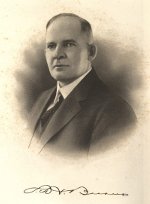 Louis Henry Burns was a native New Orleanian who served as United States District Judge for the Eastern District of Louisiana for less than three years in the 1920s.
Louis Henry Burns was a native New Orleanian who served as United States District Judge for the Eastern District of Louisiana for less than three years in the 1920s.
Judge Burns was born on May 11, 1878. He was reared in New Orleans and earned his LL.B. degree from Tulane University Law School in 1904. He was engaged in private law practice in New Orleans from 1904-1911, before becoming an Assistant United States Attorney in the Eastern District of Louisiana for two years, 1911-1913. Thereafter, he returned to private law practice in New Orleans from 1913-1921.
During his second stint in private law practice, Judge Burns was one of dozens of prominent professionals, businessmen, and politicians of South Louisiana to be featured with a full-page drawing and pithy commentary dedicated to him in the book Club Men of Louisiana in Caricature by the editorial cartoonist of The Times-Picayune, William Keevil Patrick, published in 1917. The foreword to the book written by Elbert Hubbard describes the caricatures of the men who appear in its pages, including then future Judge Burns, as follows: "No man who is not adding to the wealth, the happiness, and the welfare of the world is herein included. This is a little art gallery of American Princes. . . . an Honor Roll of some of the big boys who are making the wheels go round, who know how to work, laugh, study, play and who flavor all with love." Judge Burns is pictured in court wearing a dark suit and striped vest, appearing before a jury. The cartoon depicts him as a member of the Southern Yacht Club, the Press Club, various Carnival Clubs and "an ardent autoist." A pipe-smoking, web-footed creature drawn at his side is quoted saying, "He makes everyone but his clients hang on his words."
In 1921, he was appointed United States Attorney for the Eastern District of Louisiana and served in that position for four years, until he received a recess appointment as United States District Judge on October 3, 1925, from President Calvin Coolidge. Judge Burns was subsequently confirmed by the Senate on December 21, 1925, and received his commission that same day.
On the trial bench, Judge Burns had the odd experience of having to decide a case on the record of a non-jury trial he did not attend. The case had been tried and submitted to his predecessor, who died before entering judgment. By agreement of the parties, Judge Burns reviewed the record compiled before his predecessor and entered "a brief opinion" in favor of the defendant, dismissing the suit. His judgment was "in the nature of a general verdict," with no special findings of fact." Eighteen (18) assignments of error were made on appeal, but the United States Court of Appeals for the Fifth Circuit affirmed Judge Burns summarily, stating: "[W]ith a desire to do justice, should there by any error apparent, we have examined the record, and have reached the conclusion that the objections . . . are without merit, and that on the whole case the district court decided rightly."
Judge Burns died while still in office at the age of 50 on June 9, 1928. He is interred in Lakelawn Metairie Cemetery.
